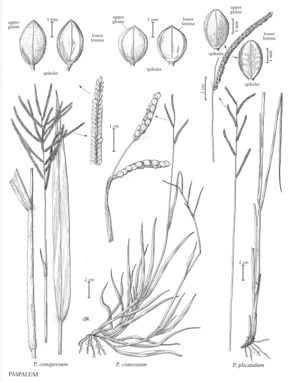Difference between revisions of "Paspalum convexum"
FNA>Volume Importer |
imported>Volume Importer |
||
| (4 intermediate revisions by 2 users not shown) | |||
| Line 4: | Line 4: | ||
|publications= | |publications= | ||
|common_names=Mexican paspalum | |common_names=Mexican paspalum | ||
| + | |special_status={{Treatment/ID/Special_status | ||
| + | |code=I | ||
| + | |label=Introduced | ||
| + | }} | ||
|basionyms= | |basionyms= | ||
|synonyms= | |synonyms= | ||
| Line 17: | Line 21: | ||
-->{{Treatment/Body | -->{{Treatment/Body | ||
|distribution=Puerto Rico;Md.;Tex.;Miss.;La. | |distribution=Puerto Rico;Md.;Tex.;Miss.;La. | ||
| − | |discussion=<p>Paspalum convexum grows in disturbed areas in the southern United States. It is native from Mexico and the Caribbean Islands to Brazil. It is not considered to have particularly high forage value.</p> | + | |discussion=<p><i>Paspalum convexum</i> grows in disturbed areas in the southern United States. It is native from Mexico and the Caribbean Islands to Brazil. It is not considered to have particularly high forage value.</p> |
|tables= | |tables= | ||
|references= | |references= | ||
| Line 26: | Line 30: | ||
-->{{#Taxon: | -->{{#Taxon: | ||
name=Paspalum convexum | name=Paspalum convexum | ||
| − | |||
|authority=Humb. & Bonpl. ex Flüggé | |authority=Humb. & Bonpl. ex Flüggé | ||
|rank=species | |rank=species | ||
| Line 33: | Line 36: | ||
|basionyms= | |basionyms= | ||
|family=Poaceae | |family=Poaceae | ||
| − | |illustrator=Linda A. Vorobik | + | |illustrator=Linda A. Vorobik;Cindy Roché |
| + | |illustration copyright=Utah State University | ||
|distribution=Puerto Rico;Md.;Tex.;Miss.;La. | |distribution=Puerto Rico;Md.;Tex.;Miss.;La. | ||
|reference=None | |reference=None | ||
|publication title= | |publication title= | ||
|publication year= | |publication year= | ||
| − | |special status= | + | |special status=Introduced |
| − | |source xml=https:// | + | |source xml=https://bitbucket.org/aafc-mbb/fna-data-curation/src/200273ad09963decb8fc72550212de541d86569d/coarse_grained_fna_xml/V25/V25_1463.xml |
|subfamily=Poaceae subfam. Panicoideae | |subfamily=Poaceae subfam. Panicoideae | ||
|tribe=Poaceae tribe Paniceae | |tribe=Poaceae tribe Paniceae | ||
Latest revision as of 17:57, 11 May 2021
Plants annual. Culms 10-53 cm, erect; nodes glabrous. Sheaths pubescent or glabrous; ligules 2-4.1 mm; blades 5-25(80) cm long, 2.9-10.2(12) mm wide, flat. Panicles terminal, with 1-5 racemosely arranged branches; branches 1.1-5.4(7) cm, divergent; branch axes 0.8-1.3 mm wide, not or narrowly winged, glabrous, terminating in a spikelet. Spikelets 2.1-2.6 mm long, 1.7-2.4 mm wide, paired, appressed to the branch axes, broadly obovate to suborbicular, shortly pubescent, light to dark brown. Lower glumes absent; upper glumes and lower lemmas shortly pubescent, 5-7-veined, margins entire; lower paleas rarely present; upper florets dark glossy brown. Caryopses 1.3-1.5 mm, white. 2n = 30,32,40,60.
Distribution
Puerto Rico, Md., Tex., Miss., La.
Discussion
Paspalum convexum grows in disturbed areas in the southern United States. It is native from Mexico and the Caribbean Islands to Brazil. It is not considered to have particularly high forage value.
Selected References
None.
